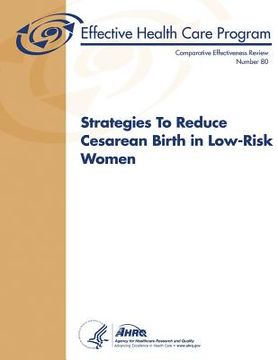Strategies To Reduce Cesarean Birth in Low-Risk Women: Comparative Effectiveness Review Number 80 (en Inglés)
Reseña del libro "Strategies To Reduce Cesarean Birth in Low-Risk Women: Comparative Effectiveness Review Number 80 (en Inglés)"
Thirty-two percent of pregnancies in the United States conclude with a cesarean birth. This record high rate reflects a relative increase of 53 percent in use of cesarean from 1991 to 2007. The pattern of increasing use of cesarean has been of concern for decades, with the last decline of 2 to 3 percent, occurring in the mid-1990s, being fully reversed by 1999, and the rate increasing over 50 percent from 1996 to 2007. Nearly one in three births by cesarean translates to a total of 1.4 million cesarean births each year, making cesarean the most commonly performed major surgery in the United States. Cesarean birth is not without consequences. In general, cesarean is more costly to the health care system, is associated with increased risk for both mother and infant, and has the potential to complicate subsequent pregnancies. Indeed, because the effects of these complications can be devastating and include fetal death, emergent hysterectomy, and maternal mortality from associated bleeding, labor and delivery units have increased the use of "code teams" that conduct practice drills to be prepared for such emergencies. Cesarean birth rates vary considerably by geographic region, ranging from 25 to 38 percent among States, with the highest rates in the southeastern United States. One research group examining differences across hospitals documented a span from 9 percent to 37 percent for primary cesarean births. While health care providers and health systems initially viewed such variation as a reflection of underlying differences in the risk profile of the women receiving care at the hospitals, it has become increasingly clear, through use of techniques such as risk adjustment, that a large proportion of variation is not explained by some facilities having much higher or lower risk patients than others. In medical care, when there is variation of the magnitude we see in use of cesarean after taking into account differences in patient characteristics, the conclusion is that provider preferences, and to a lesser extent patient preferences, are important drivers of variation. Nonetheless, relatively little focus has been placed on research specifically designed to assess strategies to reduce use of cesarean. The notable exception is a study of approaches to promote trial of vaginal birth after cesarean (VBAC). The state of general knowledge about evidence-based approaches to reduce cesarean overall is uncharted. In this review we aim to bring that literature to the forefront by systematically examining the outcomes of strategies intended to reduce use of cesarean among low-risk women. The goal of this systematic evidence review is to examine the effects of available strategies to reduce cesarean birth among low-risk pregnant women who have a singleton pregnancy, focusing on the following outcomes: route of birth, maternal morbidity and mortality, and neonatal morbidity and mortality. We synthesized evidence in the published literature to address these Key Questions (KQs): KQ1. What strategies during pregnancy are effective to reduce the use of cesarean birth among women with a singleton pregnancy who are intending a vaginal birth? KQ2. What strategies during labor are effective to reduce the use of cesarean birth among women with a singleton pregnancy who are intending a vaginal birth? KQ3. Where head-to-head comparisons are available, what strategies are shown to be superior in reducing the use of cesarean birth among women with a singleton pregnancy who are intending a vaginal birth? KQ4. What are the nature and frequency of adverse effects resulting from strategies used to reduce cesarean birth among women with a singleton pregnancy who are intending a vaginal birth?

